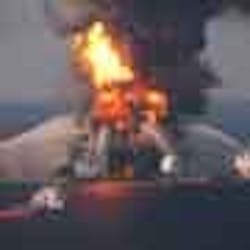Deepwater Horizon Prompts Safety Overhaul
The December 14, 2011, Deepwater Horizon report by the National Academy of Engineering (NAE) and the National Research Council (NRC), Washington, D.C., points the finger of blame firmly at the companies involved in the well operation and the regulators overseeing it.
[pullquote]The report says the lack of effective safety management among the companies involved is evident in the multiple flawed decisions that led to the blowout and explosion that killed 11 workers and produced the biggest accidental oil spill in US history. Regulators also failed to exercise effective oversight.
To reduce the risk of another, similar catastrophe, companies involved in offshore engineering are urged to take a system safety approach to anticipating and managing possible dangers at every level of operation — from ensuring the integrity of wells to designing blowout preventers (BOPs) that function "under all foreseeable conditions." In addition, an enhanced regulatory approach should combine strong industry safety goals with mandatory oversight at critical points during drilling operations.
"The need to maintain domestic sources of oil is great, but so is the need to protect the lives of those who work in the offshore drilling industry as well as protect the viability of the Gulf of Mexico region," says Donald C. Winter, former secretary of the Navy, professor of engineering practice at the University of Michigan, and chair of the committee that wrote the report. "Industry and regulators need to include a factual assessment of all the risks in deepwater drilling operations in their decisions and make the overall safety of the many complex systems involved a top priority," he adds.
Among the report's specific recommendations are a total rethink of BOP systems and the integration of the different US authorities who currently oversee offshore drilling operations.
In terms of BOPs, the report chastises both industry and regulators for a "misplaced trust" in the ability of such systems to act as fail-safe mechanisms during well blowouts: "BOP systems commonly in use — including the system used by the Deepwater Horizon — are neither designed nor tested to operate in the dynamic conditions that occurred during the accident. BOP systems should be redesigned, rigorously tested and maintained to operate reliably," the report says. Proper training in the use of these systems in the event of an emergency is also essential, it adds.
The report calls on the US to make a single government agency responsible for integrating system safety for all offshore drilling activities: "Reporting of safety-related incidents should be improved to enable anonymous input, and corporations should investigate all such reports and disseminate lessons learned to personnel and the industry as a whole."
The Deepwater Horizon disaster has already prompted the European Union (EU) to carry out risk analyses of offshore operations in its region. These have identified two main problems: the danger of a major offshore oil or gas accident occurring in EU waters is significant and the existing fragmented legislation and diverse regulatory and industry practices don't provide for all achievable reductions in the hazards throughout the EU; and the existing regulatory framework and operating arrangements don't enable the most effective emergency response to accidents wherever they occur in EU waters, and the liabilities for clean-up and conventional damages aren't fully clear.
To tackle these problems, the European Parliament and Council have published a proposal on the safety of offshore oil and gas prospection, exploration and production activities.
The general objectives of this proposal are, firstly, to reduce the risks of a major accident, and, secondly, to limit the consequences should such an accident occur. Four distinct policy options are outlined, although the EU's preferred solution involves using new laws to improve comprehensively the level of risk management and emergency preparedness in the region's offshore industry.
As well as being the most consistent approach, the EU says this provides greater transparency of both industry and regulator performance: "This option can reduce the baseline risk by 50% through enhanced prevention and mitigation should an incident nonetheless occur. The risk reduction in average monetary terms (€103455 million/yr ($134–591 million/yr)) compares favourably with the estimated cumulative costs of its implementation (€134–140 million/yr ($174–182 million/yr))."
Whichever option is finally chosen, one of the major challenges for the EU now is to adopt a common data reporting format that allows proper comparison of information from both member states and individual operators. The proposal lists ten specific examples of the minimum reporting requirements it's seeking. These include: any fatal accident; any major accident to the environment; and information relating to an unintended — ignited or otherwise — release of hydrocarbons or other hazardous substances.
SEÁN OTTEWELL is Chemical Processing's Editor at Large. You can e-mail him at [email protected].
